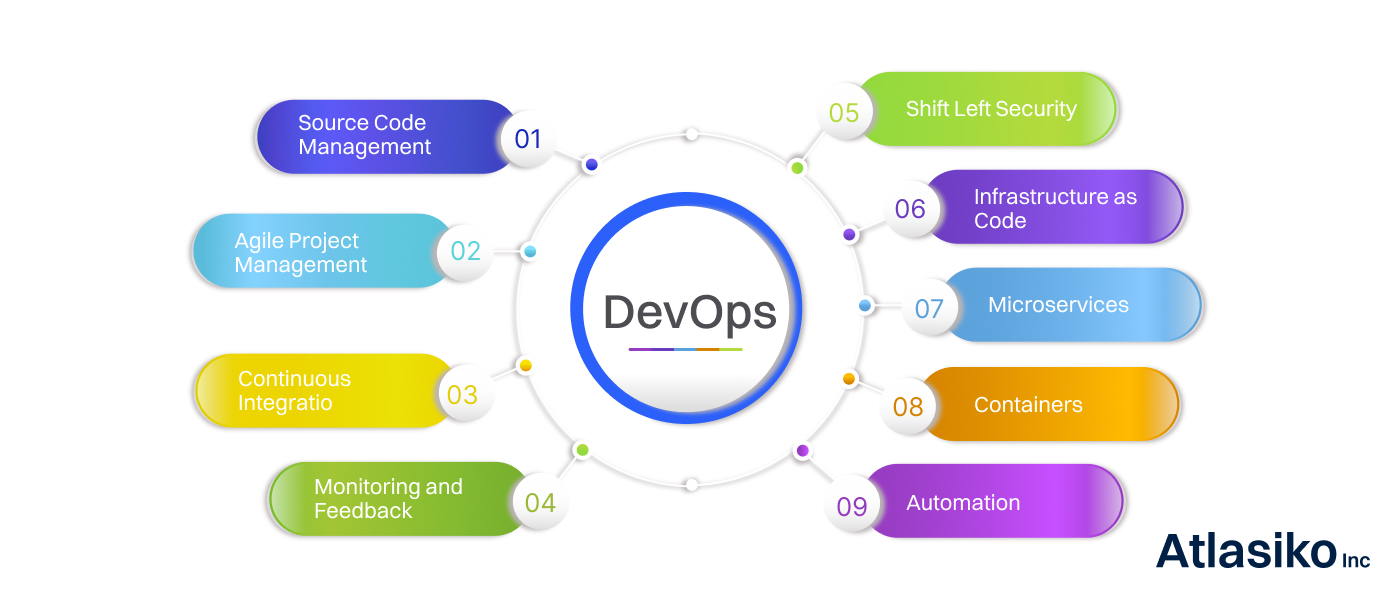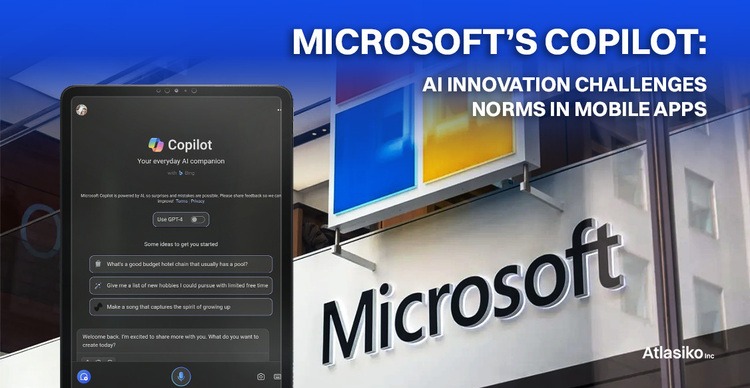Intro to DevOps
Among popular concepts of software development, DevOps has become the most frequently used and DevOps meaning in modern IT solutions production has increased significantly in recent years. Many IT service companies choose to adopt DevOps technology to enable the efficient app and software dev cycle because of the numerous beneficial features of DevOps.
Atlasiko Inc., as an experienced software development company, has great expertise in the utilization of the DevOps concept and practices to manage our projects. We also assist other businesses to develop DevOps process from scratch, create the DevOps implementation plan and deploy it in the production processes with IT consulting services by Atlasiko. Our IT solutions firm will help you to figure out what DevOps is, its main terms and principles, and learn DevOps to facilitate the management of your projects, improve product quality and enhance business success.

What is DevOps?
If you understand the definition of DevOps, it’s easier to grasp the importance and standards of efficiency of DevOps processes in software development, delivery, and customer engagement. So let’s answer the most popular question “What does DevOps mean?” and clear up some other terms and peculiarities of development operations and how DevOps works.

Even though some projects of web development might appear challenging, professionals of our team take it upon themselves to create an unparalleled solution. We develop websites and web-based apps keeping in mind business needs and goals of our clients.Let's talk
DevOps meaning
It makes sense to start to explain DevOps services with a common DevOps definition. First off, it's important to note that this word is an acronym for two words: Dev means development, and Ops meaning is operations. To better comprehend DevOps concepts and the advantageous chances DevOps for enterprises might present, let's elaborate on the term's definition to get DevOps explained fully.
When we talk about DevOps, we refer to a set of processes, techniques, and philosophical concepts in the software development process where a DevOps team works closely together and seeks to provide a quick-to-market solution. Unlike the traditional model, in DevOps software engineering team of developers closely collaborates with the Ops team to exchange knowledge, insights, and ideas for enhancing the complete product. By establishing DevOps management, a firm strengthens the connection between the creation of IT products and their deployment to consumers.
DevOps model in simple words
Let's use some DevOps examples to explain each of these DevOps terms in plain language to answer the frequent question “What does DevOps do?”. In essence, two DevOps teams split up the DevOps roles and DevOps SDLC activities in practice. The planning, coding, building, and testing phases of the DevOps cycle are handled by the Dev team, and the release, deployment, operation, and monitoring phases are handled by the operation team. The establishment of a close relationship and DevOps collaboration between these two divisions is the key purpose of DevOps among others. The development process may become burdensome and expensive without the cooperation of these two DevOps teams.
So let's imagine that the Dev team is working on a scheduling web application for some medical office as a quick DevOps example. They develop this web-based software, put it through testing, and do all necessary functional checks in their working environment. Clients begin using the web solution as soon as the operations team releases and deploys it in the IT infrastructure of the firm, which requested web app development. However, users begin to complain that some functions don't operate properly e.g. scheduled appointments get messed up because of overbooking, the app doesn’t send reminders to patients, the speed of page loading is awful, etc., even though everything appeared to be flawless in the dev environment. Naturally, the Ops team has some grievances with the developers due to the subpar nature of their solution. The Dev team defends their work, which is only appropriate given that the web-based software worked flawlessly in testing and that the Ops team must have made a mistake when applying the solution to the real world. Despite these controversies between each other, they are left with one useless product, a ton of lost effort, and a damaged reputation.
A severe lack of communication across executive departments is the fundamental cause of this. The issue would have been averted if the Ops team had participated in the DevOps development process, providing programmers with knowledge of the market and actual needs of medical offices, and developers, in turn, responded quickly to such improvement ideas by changing codes and features. The DevOps approach assumes that such continuous collaboration begins right at the concept formulation stage to guarantee success with project completion.
Our web-based applications are always efficient and interactive since Atlasiko Inc. adheres to all DevOps product standards when creating IT solutions. Request our Web app development services, which will give your company new opportunities and competitive advantages. Learn more about the DevOps process.
Overview of DevOps history
Although DevOps solutions have been used actively for about a decade now, the roots of this concept reach a while before that. DevOps model is actually a descendant of the Agile methodology of software development. The whole DevOps meaning was framed into one term in 2009 by Patrick Debois. This software development consultant named a conference ‘DevOps Days” to emphasize the weak points of Agile methods that lacked iteration of code deployment. DevOps infinity loop of software development lifecycle impressed those IT administrators, who opposed excessive change management in ITIL, and original Agile supporters.
The DevOps philosophy was popularized a few years later in 2013 because of a book called “The Phoenix Project”. It presented IT managers with a DevOps description and explained some distinguishing features of the DevOps concept.
Later on, as the DevOps introduction to the global community turned out successful, many IT services companies started to initiate DevOps learning programs for their employees. The increase in the number of skilled programmers in DevOps software building and DevOps managers led to the formulation of a new job title — DevOps engineer.
DevSecOps in the DevOps infrastructure
After we finished to define DevOps, another question might appear about a similar term — “What does DevSecOps stand for?”. The complete form of this term is DevOps Security and it refers to the system of securing the safety of developer operations and the whole Development&Operations environment with the help of special tools, strategies, and security policies. However, the DevOps practice doesn’t separate DevSecOps from consolidated DevOps workflows — otherwise, it supposes its full incorporation into all DevOps processes and activities.

Reasons why DevOps is popular
DevOps is considered to be the most influential tendency in modern software development. Understanding DevOps advantageous features, companies aspire to implement DevOps for developers and operations crew.
Moreover, global statistic data proves positive changes and increase in DevOps value. We analyzed many indices and cases of successful DevOps utilization, so let’s explore some of these metrics and beneficial (and not) characteristics of DevOps basics to find out why companies use DevOps methods and why DevOps is important as a global practice.
Pros and Cons of DevOps
International experience shows that DevOps meaning in software development businesses and their success is significant. Atlasiko Inc, as a qualified IT service provider, backups this point since we actively utilize software DevOps and Agile practices for our Software development services. So our firm can evaluate all advantages of DevOps technology from our own experience. It wouldn’t be fair play not to mention some DevOps issues and challenges that businesses learning DevOps implementation may encounter.
| Pros | Cons |
| Faster release of IT solutions because of shorted DevOps cycle | Implementation of DevOps requires significant changes in the company’s organization model |
| Enhancement of product quality with CI deployment tools | Possible overestimation of customer value can disrupt DevOps workflows and negatively influence the final product as well as the company’s revenue |
| Hastening of digital transformation processes thanks to DevOps automation practice | Companies must ensure interconnectedness of all components and pillars of DevOps concept or it won’t work efficiently |
| Building up reliability of a company and efficient risk management | |
| Improved productivity of Dev teams | |
| Transparency of software operations and dev resources | |
| Advanced recovery management | |
| Improvements in user experience | |
| Decrease of expenses |
What are DevOps statistic scores?

The most recent research called DevOps Global Market Report 2022 by ReportLinker and Global DevOps Platform Market Research Report by Market Reports World demonstrate constant growth of DevOps solution utilization. Here are some major stats on the market size of DevOps for infrastructure and numbers of the growth rates globally and by region.
- In 2021 the global DevOps market was estimated at $7.20B. This number is expected to increase to $8.95B by the end of 2022 and to $20.53B in 2026.
- The compound annual growth rate (CAGR) in 2022 is predicted to be 24.2% and maintain this percentage at 23.08% in 2026.
- Market Reports World predicts global DevOps value to grow to $25.79B by 2028.
- The USA segment of DevOps solutions held 65% of the market share in 2021 which makes the North-American region the largest in the DevOps market.
- Google shares the report on the Harvard Business Review Analytics Services survey which results show that 86% of over 600 respondents admit the importance of the capability to quickly develop and deploy software.
- The same survey shows that 77% of interviewed companies use the DevOps model.
- The DevOps Trends Survey (2020) presents us with the fact that out of 500 DevOps managers and specialists who were respondents almost 99% acknowledge positive outcomes for their companies.
DevOps software development life cycle vs Traditional software development practice
| DevOps cycle | Traditional SDLC | |
| Efficiency of development cycles | DevOps deployment methodology supposes small releases with frequent modifications and testing which make the dev cycle less risky. As a result, IT product development is easier to manage and quicker to fix issues, leading to more cost, time, and quality-efficient outcomes. | The main focus is on big releases of software as a result of a long development process. Although release performances look commercially advantageous, there are more risks, and fixing bugs takes more time and effort. |
| Schedule management | DevOps workflow is organized in small cycles by dedicated teams. Frequent releases are much easier to plan and schedule DevOps work. Instead of monthly planning, you’ll need to schedule a week of development and operations. Automated tools will help to set timelines for DevOps activities. | Scheduling might appear challenging as traditional software development operations have many components in their cycle. IT managers and admins always have to make sure that all schedules are agreed upon. They usually enable it via scheduling systems. |
| Data collection and utilization | The DevOps loop and automation tools enable quick and efficient data gathering and processing by dedicated DevOps teams. The automated analysis allows utilizing the results for software improvements. | To collect data you’ll need to gather reports and insights from numerous departments and siloed teams of the SDLC. It surely takes more time and disrupts ways of receiving relevant information in time. |
| Business culture | The DevOps philosophy accepts the possibility of bugs and problems in advance. It allows the accelerated building of risk management plans and their prompt execution. This culture implies that early failures positively impact the whole process because it enables quick detection of issues and recovery. DevOps concept suggests it’s better than failing at the end of the project with no time to react. | Traditional SDLC is focused on preventing business disruption and taking as less risks as possible to avoid any failure. This model supposes impeccable task performance. However, this same cultural tendency puts a lot of pressure on the development process and all stakeholders. Even the smallest post-release issues, which are inevitable, require extra effort and money. |
| Key performance indicators | A DevOps company can define its project's success by assessing spendings, the capacity of work done, and the time of productive activities. The last indicator is significant in development operations because it shows overall efficiency and encourages seeking ways and DevOps means of hastening processes without affecting IT solution quality and costs. With the DevOps flow, it’s easier and faster to find sections of waste. | Mostly, to define whether the project is successfully performed, software capacity and cost are considered. Developers estimate how much work was done and how much it cost. If they didn't cross any budget limitations or even used less for the amount of labor, then software development is successful. However, cutting expenses may be difficult and negatively influence the IT product. To solve costs issues companies often use IT outsourcing services. |
| Release and updates | As the DevOps delivery of IT products happens frequently thanks to the CI/CD DevOps solutions, automation, and shortened development cycles, software releases usually don’t organize with fancy events. Continuous updates are set up automatically with testing procedures. Companies release software officially to the public only after it went through the probation period. | Software release and deployment of updated versions usually are accompanied by a big public event. The main reason is that it presents the results of long-term work and the value and size of solutions and their updates are significant. The single release brings many risks, though, since many issues might occur in the post-implementation period. |
DevOps concepts and fundamentals
Despite knowing the DevOps meaning and definition, there are plenty of other DevOps terms you should get acquainted with. Understanding this fundamental DevOps terminology will help in learning DevOps tendencies and adapting to new DevOps needs.
Source Code Management
Tracking and managing source code changes is a technique known as source code management (SCM). DevOps developers and other interested parties can view a comprehensive history of any modifications made to a shared codebase using SCM. This guarantees that developers are using the most recent code and that no incompatible modifications have been made.
Agile Project Management
The iterative process of agile project management means that changes may be made in a way that is sensitive to customer feedback at every level of the DevOps process flow. This makes it possible for project Dev teams to use agile project management techniques to complete tasks quickly and cooperatively while staying within a project's budget and time limitations.
Continuous Integration and Continuous Delivery
Basics of DevOps like Continuous Integration and Continuous Delivery (CI/CD) enable teams to deliver software quickly, safely, and consistently. Software engineers frequently integrate their modifications into a common repository using the CI method, which is followed by automated building and testing. The main objectives of CI are to detect and resolve issues more quickly, enhance the quality of the program, and shorten the time it takes to verify and publish new software updates. By delivering all code updates to testing or production processes after the build stage, the continuous delivery foundation improves on continuous integration.
Monitoring and Feedback
DevOps experts can also keep an eye on the efficiency and security of code releases on DevOps infrastructure, networks, and systems thanks to monitoring tools. They can fuse operational intelligence-producing technologies for analytics with monitoring. These tools are combined by DevOps groups to examine how alterations to the code impact the infrastructure as a whole.
Shift Left Security
In the context of the DevSecOps organizational model, when we talk about the shift left meaning, we refer to a DevOps team's activities to ensure program security at the very beginning of the DevOps cycle (cooperation between development, security, and operations). By setting up DevOps and security to operate together, Shift Left security shortens the interval between releases and improves the quality of IT solutions.
Infrastructure as Code
Achieving effective DevOps implementation requires the capacity to deploy, configure, and manage infrastructure rapidly and systematically, regardless of whether your firm uses an on-premise data center or is entirely in the cloud. Infrastructure as Code (IaC) approaches your infrastructure concepts as actual code by using engineering controls, code reviews, tests, etc.
Microservices
Software can be built as a collection of small services using the microservices architectural design strategy. Each service has its own running process and interacts with other services using a minimalistic mechanism and a well-organized interface. Microservices can be created using a variety of frameworks or programming languages and deployed individually, as a single service, or as a collection of services.
Containers
For programs to execute in isolation on a shared OS, containers are used. Containers offer abstraction so that code can continue to function correctly on various underlying hardware from dev to test and stage levels and then to operations. Container orchestrators automate the deployment, scaling, and maintenance of containers.
Automation
One of the most crucial DevOps terms is automation since it allows DevOps teams to complete the DevOps software development and deployment of high-quality software considerably more swiftly. With automation, the time it takes to create, check, and deploy code can be greatly decreased by only sending the code's modifications to a repository for source code

DevOps methodologies
The Agile development concept, as a predecessor of the DevOps model, passed down various methodologies of software development. Let’s explore some of the most frequently used DevOps operations methods.
- Scrum
Scrum is a methodology that gives people the opportunity to tackle complicated adaptive challenges and produce products of the greatest quality at the same time within its framework. - Kanban
Kanban is one of the DevOps methods for organizing product development that places a focus on continuous delivery without overtaxing the Dev team. Kanban is a method intended to facilitate better teamwork and increase DevOps teams’ productivity, much like Scrum. - Lean development
Lean development is the application of the principles and procedures of lean manufacturing to the field of software development. Lean provides a theoretical foundation, guiding ideals and concepts, as well as tried-and-true best practices, to assist agile businesses. - Scaled Agile Framework
An array of organizational and systematic principles called the Scaled Agile Framework is designed to help businesses scale lean and agile processes. One of the many frameworks among the DevOps methodologies that aim to solve the issues that arise when extending beyond a separate team is SAFe. - Extreme Programming
Extreme programming (XP) is an approach to software development that aims to increase software responsiveness to shifting client needs. In order to boost efficiency and establish milestones where new user requirements can be accepted, XP advocates for updates and patches with short development cycles.
Conclusion
We hope this article has provided you with a clear answer to the frequently asked question "What is DevOps? ”. Now that you are aware of DevOps meaning, it’s easier to notice and acknowledge its positive influence on the creation of applications. The DevOps model improves productivity and hastens the release of new software or updated versions to the market thanks to innovative DevOps solutions.
Atlasiko Inc. effectively applies DevOps principles. Our IT services company's Dev teams work quickly and effectively to code, create software and applications, and test them thoroughly. Operations teams provide automated infrastructures, manage software releases and monitoring, and collaborate with development teams on improvements. You can securely give your company the services and talents it needs to maximize application performance and strengthen IT infrastructure with Atlasiko IT outsourcing services.







